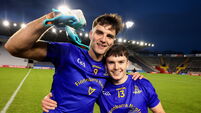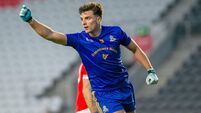A man in total harmony with the ball

THERE is a saying in the Gaeltacht, “an té is ciúine, is é is buaine” that roughly translates as ‘he who is silent is stronger or, perhaps, ‘the quiet ones last longer’. Those words came to mind these last few days when reflecting on the amazing career of Tomás Ó Sé, whose staying power and longevity was just one indication of his worth.
Quite simply, Tomás was a remarkable footballer.
To see him at close quarters on one of his marauding gallops into frontier country was something to behold. Gliding over the grass, only hitting the ground in patches, he made even the best of ball carriers look a little gauche, a little boring.
With the advent of GPS tracking devices and all other kinds of analysis, there is very little left to the imagination anymore. But I’d love somebody to tell me how much purchase Tomás got on those long loping strides of his when in full flight with ball in hand. I’ve never seen someone to eat up the ground like he could. It’s a rare quality in a footballer to be faster with the ball than without.
And yet, as I sometimes remind him, if he was a half a yard quicker, he’d have one All-Ireland medal less than the five he has today! I refer to the dying moments of the drawn All-Ireland final in the year 2000 when Tomás, in the immortal words of Páidí, “had his washer out” chasing a goal-bound Michael Donnellan and trying in vain to grab jersey. Had he caught up with him and tested the fabric of the maroon jersey, I have no doubt it would have led to a pointed free-kick that would have swung the game and the title for Galway. It was an education, an eye opener and a lucky break. After that Tomás had a great sense of timing when the game was up for grabs.
Very few footballers were as central to as many big moments in big matches as Tomás was. From that magnificent period of innocence at the turn of the millennium to the heroism of September 1st against Dublin, his career is bejewelled with brilliant flourishes, eye-catching canters and memorable scores.
And there is so much to remember and admire. There was the magnificent point he swung over at a crucial time in the 2005 Munster final in Páirc Uí Chaoimh to break the Rebels momentum. Or the All-Ireland Final later that same year, when he raged against the dying of the light against Tyrone. Two years later when things were getting sticky against Monaghan, it was Ó Sé’s fisted point that won the quarter final and two years after that again, when Cork were breathing down their necks in an All Ireland final, he was there to pull Kerry out of a hole. Right to his very last game when, in the tradition of the sons of Sparta, he was carried out on his shield, Tomás always seemed to time his input for the occasion of Kerry’s greatest need. He spoke earlier in the week of his disappointment at losing a game for the ages to Dublin but it was a good way to say goodbye. In his newspaper column a few weeks back, Darragh Ó Sé spoke of his brother’s state of exhaustion at the end of that Dublin match. Tomás knew he was in trouble:
“He was so tired at that point in the game he could hardly lift his hands over his head. He says he was so wrecked he couldn’t even shout at the fellas around him to go back in his place. It was pure thickness that was carrying him back up the pitch.”
It was mostly that thickness that carried him through a career in which he saw off some of the best wing forwards in the game.
Thickness and raw talent and, of course, dúchas. It is impossible to speak of Tomás without mentioning Páidí. If Darragh most closely resembles their late uncle in terms of personality and charisma, Tomás was his natural successor on the field. Hard, aggressive, driven.
On a personal level, I got to know Tomás playing with An Ghaeltacht and later during the three years we spent living together above the Windmill Bar on Henry Street in Limerick and in other assorted kips around the city. But, like many, I really only scratched at the surface. When you looked at Tomás before or after matches — the gearbag slung over the shoulder, baseball cap firmly pulled down over the head, purposeful stride and no eye contact — you always had the sense of being shut out. But it wasn’t really that he was shutting others out, more that he was shutting himself in.
It has been said before one of the great things about Kerry teams with Tomás Ó Sé was that they kept coming back. If you were to deconstruct the teams of his era, Tomás was the one constant. He always got the number five jersey. It was always left to the opposition to figure him out.
The day had to come when he wouldn’t be back and if winning All-Ireland medals was what it was all about, you could say that in winning only five Tomás wasted two thirds of his 15-year career!
Of course all great sportsmen know there is bit more to the game than that. They know, as the poet Ted Hughes did, that “the only calibration that counts is how much heart people invest” and, on that score, Tomás Ó Sé didn’t waste a single second.
How will Tomás Sé will be remembered as a footballer? Probably as a player on the move, a man in total harmony with a ball. For 15 years he brought Kerry folk an indecent amount of joy. And comfort too. Because when Tomás Ó Sé took off with the ball, in Kerry at least, everything seemed right with the world. Everything was going to be just fine — sure Tomás has it now. The announcement of his retirement was greeted with the sadness reserved for the great ones when they go. But there was a sense of awe too at what he had achieved. He went straight into the pantheon of players about whom we will whisper reverently for as long as we live, ‘I saw him play, you know.’








